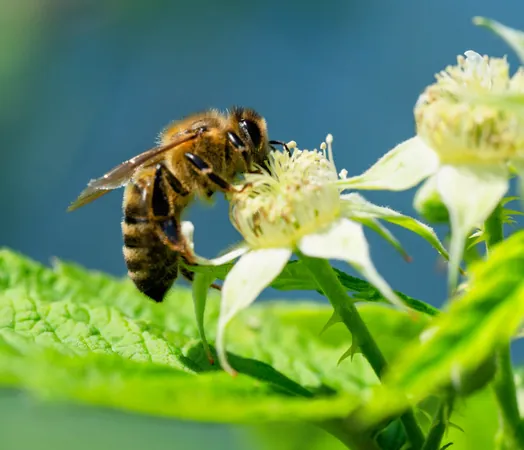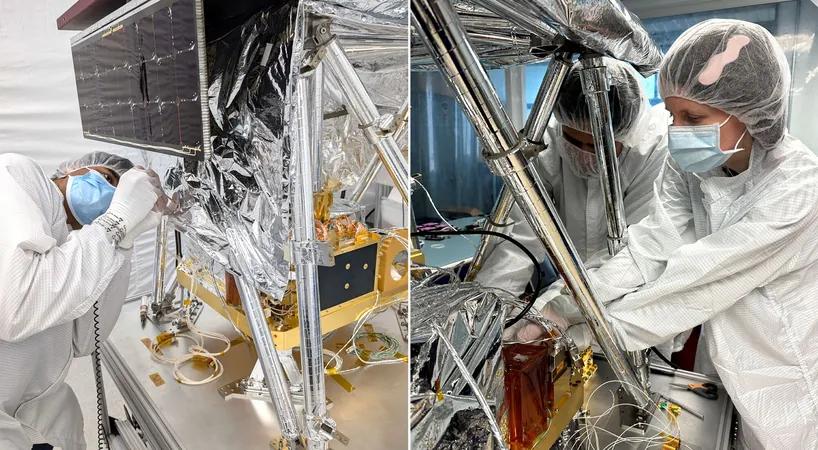
Uncovering the Hidden Buzz: How Heat and Pollution Are Altering Bee Behavior
2025-07-10
Author: Arjun
The Vital Role of Bees in Our Ecosystem
Bees are not just beautiful creatures; they are essential pollinators crucial for the health of our ecosystems. Yet, these industrious insects are facing unprecedented challenges due to environmental changes.
The Shocking Impact of Rising Temperatures and Pollution
Recent studies reveal that increasing temperatures and pollution are drastically affecting the way bees communicate through their unique buzzing. This buzzing is much more than mere background noise—it is vital for their survival and the health of the ecosystems they support.
The Hidden Power of Bee Muscles
Bees are renowned for their rapid and efficient flight—but what many people don’t realize is that their flight muscles play critical roles beyond flying. According to Dr. Charlie Woodrow from Uppsala University, these muscles are essential for communication within the hive, defense against threats, and a captivating behavior called buzz pollination.
Buzz Pollination: A Fascinating Process
Buzz pollination is a remarkable behavior where bees vibrate their bodies to dislodge pollen from certain flowers. Dr. Woodrow explains that this involves the bee curling around the pollen-concealing anthers and contracting its flight muscles up to 400 times per second to shake the pollen loose, showcasing amazing energy and precision.
Technological Advancements in Research
To further their research, Dr. Woodrow's team utilized accelerometers to measure buzzing frequencies among buff-tailed bumblebees in Europe. This groundbreaking method helps to link the vibrations bees produce directly to their communication and pollination abilities.
The Temperature Connection
One startling discovery is the much stronger influence of temperature on buzzing than previously thought. Dr. Woodrow highlights that understanding temperature's role could revolutionize pollination research, which had largely overlooked this important factor.
Pollution's Disturbing Influence on Bee Behavior
Collaboration with Dr. Sarah Scott from Newcastle University further revealed that heavy metals in the environment lower buzzing frequency in bees. Interestingly, experiments showed similar effects of temperature on buzzing regardless of location, suggesting that muscle physiology may be more significant than local adaptations.
A New Lens on Bee Health Monitoring
This research holds significant implications beyond academic interests—by understanding how environmental changes impact buzzing, scientists can develop new methods to monitor bee health. Dr. Woodrow believes that buzzy patterns could serve as early indicators of stress or environmental changes, offering insights into ecosystem health.
The Broader Ecological Impact of Disrupted Buzzes
Disruptions in buzzing may not only harm bees but could also affect their ability to communicate, regulate body temperature, and gather resources for their young. Such disruptions could ultimately hinder pollination and threaten plant reproduction.
The Worrying Future of Buzzing Bees
One particularly alarming insight is that rising temperatures might cause bees to avoid flowers that require buzz pollination, a shift that could destabilize entire ecosystems reliant on bee-pollinated plants.
Future Innovations Based on Bee Research
Despite these challenges, there is a silver lining: Dr. Woodrow’s team is exploring applications for their research in robotics. They aim to develop micro-robots that can mimic the buzzing of bees to assist with pollination, showcasing a novel intersection between nature and technology.
Urgent Action Needed to Protect Our Pollinators
These groundbreaking findings will be presented at the Society for Experimental Biology Annual Conference in Antwerp, Belgium, in July 2025. As bees grapple with an increasingly hostile environment, understanding the significance of their quiet buzz has never been more critical. These tiny vibrations may very well hold the secret to preserving biodiversity and ensuring a sustainable future.





 Brasil (PT)
Brasil (PT)
 Canada (EN)
Canada (EN)
 Chile (ES)
Chile (ES)
 Česko (CS)
Česko (CS)
 대한민국 (KO)
대한민국 (KO)
 España (ES)
España (ES)
 France (FR)
France (FR)
 Hong Kong (EN)
Hong Kong (EN)
 Italia (IT)
Italia (IT)
 日本 (JA)
日本 (JA)
 Magyarország (HU)
Magyarország (HU)
 Norge (NO)
Norge (NO)
 Polska (PL)
Polska (PL)
 Schweiz (DE)
Schweiz (DE)
 Singapore (EN)
Singapore (EN)
 Sverige (SV)
Sverige (SV)
 Suomi (FI)
Suomi (FI)
 Türkiye (TR)
Türkiye (TR)
 الإمارات العربية المتحدة (AR)
الإمارات العربية المتحدة (AR)